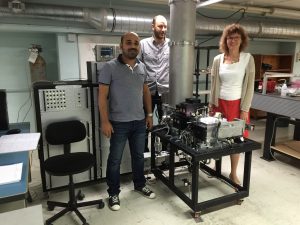2017
NANOCOSMOS Interstellar Dust Meeting
Date: 12 – 13 June 2017
Place: Université Paul Sabatier (Toulouse, France)
Key dates:
Abstract submission deadline: April 30th, 2017
Registration deadline: May 14th, 2017
Webpage: https://epolm3-nanocosm.sciencesconf.org/
2016
European Conference on Laboratory Astrophysics – Gas on the Rocks (ECLA2016)
Outcome of the conference: See “A summary of the ECLA2016” link
November 21 – 25, 2016 (CSIC Headquarters, Madrid, Spain)
Webpage: ECLA2016
FIRST ANNOUNCEMENT
Key dates:
Second announcement: February 1st, 2016 (opening of the conference web page).
Deadline for abstract submission: June 15, 2016
Deadline for early registration: July 15, 2016
Deadline for information participants about selected contributing talks: June 30, 2016
Final program: July 15, 2016
Last announcement with final details: November 1st, 2016
Motivation:
Over the last decade, European research activities in the field of laboratory astrophysics have experienced an impressive increase in their potential to address astrophysical problems, in particular by providing essential information on the physical and chemical processes leading to chemical complexity in space resulting in star and planet formation. These activities have been motivated by the interpretation of astronomical observations obtained with single dish telescopes and short baseline interferometers. The wealth of data obtained with ALMA, space facilities (Herschel, Spitzer, Rosetta, the coming JWST, E-ELT), and other ground based observatories (VLTI, NOEMA, …), require new methodologies for the astrophysical modeling that will lead to new challenges for laboratory astrophysics.
This conference aims to address the state of the art in laboratory astrophysics within the context of these new astrophysical data and to improve communication and collaboration between astrophysicists, physicists and (geo) chemists. Hence, the conference structure will consist of invited talks presenting topics in astrophysics and planetary science and related laboratory astrophysics activities. Contributing talks will be selected to complement the topics from the astrophysical, laboratory, and theoretical/modeling points of view.
The astrophysical areas that will be addressed are:
Comets, asteroids, meteorites and the primitive Solar System nebula: formation and evolution
Protoplanetary disks and planet formation
Planet, Moon, and exoplanet surfaces and atmospheres
The signatures of the evolving interstellar medium
Dense Clouds: the gas-ice interface
Chemical fingerprints of star formation
The late stages of star evolution: dust formation
Supernovae and shocks: high-energy processing of matter
The conference will cover studies in many fields such as spectroscopy, analytical (geo) chemistry, reactivity, nanoscience, and quantum chemistry, pertaining to different matter components (gas, plasma, PAHs, ices, dust, solid surfaces, …).
SOC composition
Jose Cernicharo (chair). ICMM-CSIC, Madrid, Spain
Christine Joblin (co-chair). IRAP, Univ. Paul Sabatier/CNRS, Toulouse, France
Isabel Tanarro. IEM-CSIC, Madrid, Spain
Jose Angel Martín Gago. ICMM-CSIC, Madrid, Spain
Karine Demyk. IRAP, Univ. Paul Sabatier/CNRS, Toulouse, France
Jean-Hugues Fillion. LERMA, UPCM Univ. Paris 06, & Obs. Paris, France
Maria Elisabetta Palumbo. INAF-Catania Astrophysical Obs., Italy
André Canosa. IPR, Univ. Rennes 1/CNRS, France
Harold Linnartz. Leiden Obs., Univ. of Leiden, The Netherlands
Liv Hornekaer. iNANO, Aarhus Univ., Danemark
Peter Sarre. School of Chemistry, Nottingham Univ., UK
Stephan Schlemmer. Phys. Inst., Univ. Koln, Germany
Jonathan Tennyson. Univ. College London, UK
Yves Marrochi. CRPG-CNRS, Nancy, France
Guillermo Muñoz Caro. CAB, INTA-CSIC, Madrid, Spain
LOC composition
Isabel Tanarro (Chair). IEM-CSIC, Madrid, Spain
Belén Maté. IEM-CSIC, Madrid, Spain
Víctor J. Herrero. IEM-CSIC, Madrid, Spain
José Luis Doménech. IEM-CSIC, Madrid, Spain
Ángel González-Valdenebro. IEM-CSIC, Madrid, Spain
Marcelo Castellanos (co-chair). ICMM-CSIC, Madrid, Spain
Belén Tercero. ICMM-CSIC, Madrid, Spain
Juan Ramón Pardo. ICMM-CSIC, Madrid, Spain
Juan Antonio Corbalán. ICMM-CSIC, Madrid, Spain
Natalia Ruiz-Zelmanovich. ICMM-CSIC, Madrid, Spain





